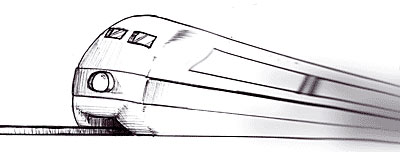
Illustration Arnie Bermudez
|
|
By Kendrick Wilson
Arizona Daily Wildcat
Monday October 20, 2003
A major city election is only two weeks away. Those UA students who are registered must make big decisions on Nov. 4 ÷ or sooner, if they vote by mail ÷ that will have an enormous impact on the university and the community as a whole for years to come.
Perhaps one of the most important, and most controversial, issues that will appear on ballots is a comprehensive transportation plan that comes in the form of propositions 200 and 201.
The plan is often referred to as a "light rail" plan, which is misleading. Light rail accounts for only 22 percent of the plan's funding. Forty percent will be spent improving bus service, 20 percent to improve and repair neighborhood streets, 10 percent to build new bike lanes, bike crossings and sidewalks, six percent to extend the Fourth Avenue Trolley into downtown and two percent to improve enforcement.
The plan would be funded by a one-third cent sales tax increase and a six cent construction tax increase. Overall, it has been estimated that it would cost the average Tucson household $29 per year ÷ not per person, per household. The cost for the average UA student would be considerably less.
Because of the state's complicated tax-levying laws, the plan had to be split into two separate propositions. Prop. 200 is dedicated to funding the plan, while Prop. 201 details where funds would go. Both of them must pass for the plan to go into effect.
This plan would have an enormous impact on UA students, both those that live near to and far from campus. The light rail line would have two major stops along the UA's southern edge on Sixth Street. It would run east to Country Club Road and then move south to Broadway Boulevard and continue east past Park Place Mall. To the west, the rail line would continue up Sixth Street to Stone Avenue, where it would head south through downtown and then continue down Sixth Avenue past South Tucson.
Before the rail lines can be built, the plan would immediately improve Sun Tran service with newer, cleaner buses that run every 10 minutes along major routes near the UA.
Steve Farley, who works with Citizens for a Sensible Transportation Solution, the group that introduced the two propositions, explained how the plan could affect students in a variety of ways.
"All of a sudden, the number of housing options explodes," he said. "You no longer have to choose between living close to campus and owning a car."
And students who live on campus would no longer be restricted to the university area.
"Students who live on or near campus would now be able to travel all over town without a car," he added.
Students who currently use Sun Tran know how desperately Tucson's transit system needs to be upgraded.
Matt Shaw, a materials science and engineering junior, has to leave his east side house at 7:30 a.m. to be on time to his 9 a.m. class.
"I catch the bus at least 30 minutes early because I've had one breakdown on the way to campus before," he said. "Even if the bus doesn't break down, it's always at least five minutes late by the time it gets to campus."
Unfortunately, not everyone is singing the praises of 200 and 201. Under the auspices of a group named "Independent People Like You," billboard, radio and TV ads have sprung up against the plan. A recent Arizona Daily Star report revealing the identities of the contributors to the group confirmed that it would be better named "A Thinly-Disguised Group of Tucson's Wealthiest Developers."
One billboard on Broadway Boulevard proclaims, "Volgy and Ibarra (two supporters of the plan) want to rip up Broadway for light rail."
Actually, two lanes of traffic in both directions would remain open during the entire construction of a light rail line, which would only be done on 1500 feet of roadway at a time. Business access would not be restricted during construction, either.
It has been a common quip of opponents of the plan that light rail is nice and idealistic, but won't solve anything. It's important for voters to remember that the plan covers much more than light rail and that no single solution by itself could be a panacea for all our transportation problems. Road widening has been treated as the only solution for years, and the result is the current state of Tucson's transportation system.
Light rail and better bus service would also help drivers who have no intention of using it. By getting new riders who use the improved system off the road, it would be easier for people who continue using their cars to get through traffic.
Big-time developers have had their way for years and the result is the mess we deal with every time we get behind the wheel. If we don't send a resounding message that better transportation is more important than developers' profits, we will be headed for disaster.
-Kendrick Wilson is a political science junior. He can be reached at letters@wildcat.arizona.edu.
